The Pharmaceutical Marketing System involves many strategies used to promote pharmaceutical products, including direct sales, digital marketing, and healthcare professional outreach. With a focus on global share, it examines the market distribution, competition, and trends across different regions, highlighting the industry’s evolution in response to regulatory, economic, and technological changes.
Table of Contents
Pharmaceutical Marketing System
The pharmaceutical marketing system is a specialized field of marketing aimed at promoting and distributing pharmaceutical products while adhering to stringent regulations and ethical practices.
It encompasses a variety of strategies and efforts to ensure medicines and healthcare products reach the target audience, including healthcare providers, patients, and institutions. This system involves multiple departments, each playing a critical role in achieving organizational goals and ensuring compliance with legal and ethical standards.
Core Components of Pharmaceutical Marketing
1. Product Development and Management
Product Management department (PMD) collaborates with research and development (R&D) to bring new drugs to market. It focuses on product lifecycle management, positioning, and pricing strategies.
Key Responsibilities:
i) Gathering market feedback during product development.
ii) Identifying therapeutic needs and opportunities.
iii) Managing post-launch product updates and improvements.
2. Market Research
Market research provides data-driven insights into customer needs, market trends, and competition. This department ensures that marketing strategies are targeted and effective.
Key Responsibilities:
i) Connecting with patients and healthcare professionals through focus groups, interviews, and surveys.
ii) Analyzing market share, competitor products, and pricing.
iii) Identifying new market opportunities and gaps.
3. Sales and Distribution
This department ensures that pharmaceutical products reach healthcare providers, pharmacies, and end-users effectively and efficiently. It also works closely with distributors to maintain product availability.
Key Responsibilities:
i) Establishing and maintaining relationships with healthcare professionals (HCPs).
ii) Managing distribution channels to ensure a steady supply chain.
iii) Achieving sales targets through effective promotion and negotiation.
4. Medical Affairs
Medical affairs serve as the scientific backbone of pharmaceutical marketing, bridging the gap between marketing and clinical practice. This department ensures that all marketing efforts are scientifically accurate and compliant.
Key Responsibilities:
i) Educating HCPs on the clinical benefits of products through medical representatives.
ii) Providing scientific data and clinical trial results to support product claims.
iii) Addressing queries and concerns from HCPs and patients.
5. Regulatory Affairs
Regulatory affairs ensure all marketing activities comply with government regulations and ethical standards. This department is critical for approval processes and maintaining product safety standards.
Key Responsibilities:
i) Preparing and submitting marketing authorization applications.
ii) Ensuring promotional materials are compliant with regulatory guidelines.
iii) Staying updated with changing laws and standards.
6. Digital Marketing
In the digital age, this department focuses on promoting pharmaceutical products through online platforms, reaching a broader audience effectively.
Key Responsibilities:
i) Managing company websites, social media accounts, and email campaigns.
ii) Developing content for digital platforms to educate and engage HCPs and patients.
iii) Monitoring online trends and adapting strategies for better outreach.
7. Public Relations and Corporate Communications
This department handles communication with the public, stakeholders, and the media to maintain a positive corporate image.
Key Responsibilities:
i) Issuing press releases about new products and initiatives.
ii) Managing crises or product recalls effectively.
iii) Building partnerships with healthcare organizations and advocacy groups.
8. Training and Development
Continuous training for the sales team, medical representatives, and other marketing staff is crucial to stay updated on product knowledge and industry trends.
Key Responsibilities:
i) Designing training modules for new hires and existing employees.
ii) Conducting workshops on communication, ethical marketing, and product-specific information.
iii) Evaluating the effectiveness of training programs.
9. Finance and Budgeting
This department oversees the allocation of resources and budgeting for marketing campaigns, ensuring cost-effectiveness and profitability.
Key Responsibilities:
i) Setting budgets for marketing activities and campaigns.
ii) Monitoring expenditure and return on investment (ROI).
iii) Collaborating with marketing teams to optimize resource utilization.
Challenges in Pharmaceutical Marketing
Regulatory Hurdles: Strict government policies limit how products can be marketed.
Ethical Concerns: Balancing profit motives with the well-being of patients.
Market Competition: A highly competitive industry requires innovative strategies.
Changing Trends: The growing influence of digital platforms demands adaptability.
Global Share Analysis
The pharmaceutical industry plays a significant role in global healthcare, contributing significantly to economies worldwide. Its marketing strategies are essential to ensure the accessibility and awareness of life-saving drugs and therapies. This article explores the global share of pharmaceutical marketing, supported by a chart illustrating the industry’s distribution across various regions.
Global Pharmaceutical Market Overview
The global share of pharmaceutical market is vast, with an estimated value of $1.48 trillion (2023), expected to reach approximately $1.8 trillion by 2028. Key players include North America, Europe, Asia-Pacific, Latin America, and the Middle East & Africa, each contributing significantly to this value.
Pharmaceutical marketing strategies typically focus on two primary customer groups:
Healthcare Providers (HCPs): Medical professionals who prescribe medicines.
Consumers: Patients and end-users of pharmaceutical products.
Global Share of Pharma Market by Region
Below is an analysis of the global share of pharmaceutical market based on major regions:
North America (45%)
Dominate the market due to the presence of large pharmaceutical companies, significant R&D investments, and high healthcare expenditure.
The United States is the largest single market globally, with advanced marketing strategies such as digital advertising, direct-to-consumer (DTC) campaigns, and data-driven analytics.
Europe (24%)
Europe holds the second-largest market share, with Germany, the UK, and Switzerland being prominent hubs for pharmaceutical innovation.
Marketing efforts here focus on healthcare professionals, owing to stricter regulations on direct consumer advertising.
Asia-Pacific (20%)
A rapidly growing market driven by increasing population, rising healthcare needs, and expanding middle-class affordability.
Countries like China, India, and Japan are significant contributors, with a shift toward digital marketing and rural healthcare outreach.
Latin America (7%)
Includes emerging markets like Brazil and Mexico, where healthcare reforms and growing pharmaceutical infrastructure are boosting growth.
Marketing efforts are tailored to reach diverse populations and address affordability.
Middle East & Africa (4%)
A smaller market share but with significant potential, driven by increasing investment in healthcare infrastructure.
Marketing strategies often focus on partnerships with governments and NGOs.
Chart: Global Share of Pharmaceutical Market by Region

The chart emphasizes North America’s dominance while highlighting Asia-Pacific’s rapid growth.
Future Trends in Pharmaceutical Marketing
Digital Transformation: Increased use of AI, big data, and digital channels to target specific audiences efficiently.
Personalized Marketing: Focus on tailored therapies and precision medicine.
Emerging Markets: Investments in Asia-Pacific and Africa to tap into unmet healthcare needs.
Regulatory Evolution: Adapting to stricter regulations on advertising and consumer outreach.
Conclusion
Pharmaceutical marketing is a dynamic and competitive field, significantly impacting global health and economy. While North America leads the market, regions like Asia-Pacific and Latin America present promising opportunities for growth. By leveraging innovative strategies and adapting to regional needs, pharmaceutical companies can continue to expand their reach and influence.
Read Also:
Product Management Department in The Pharmaceutical Industry (PMD)

Abdus Sobhan Salim is professional experienced pharmacist in pharmaceuticals, author and founder of pharmabossbd.com, the first Bangladeshi pharmaceutical blogger since 2019.



